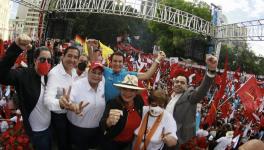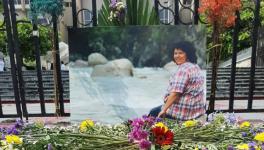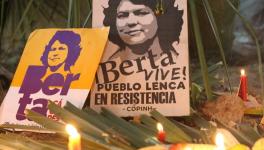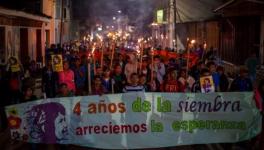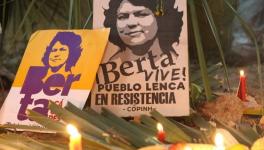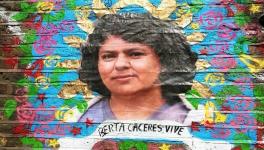Civic Council of Popular and Indigenous Organizations of Honduras: 25 years of struggle and Revolution
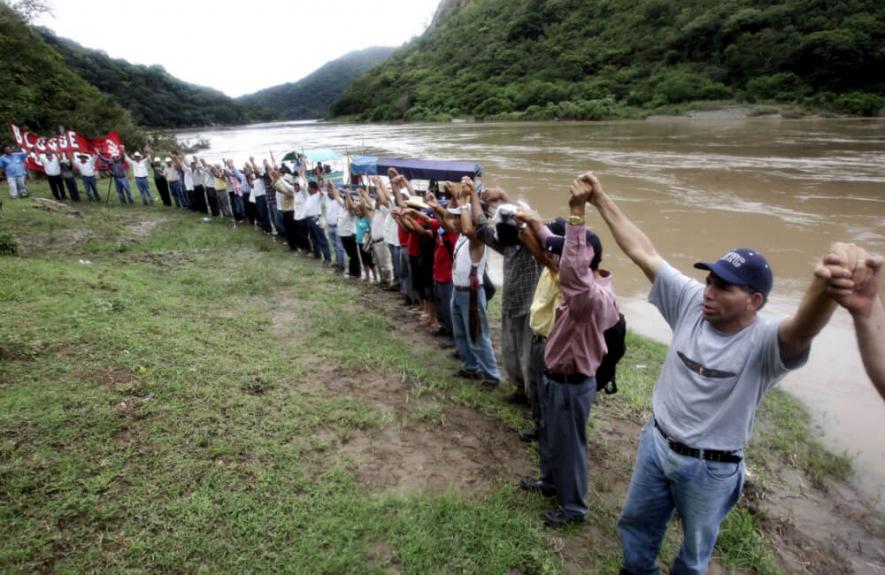
On the eve of the 25th anniversary of the Civic Council of Popular and Indigenous Organizations of Honduras (COPINH), two years after the assassination on March 2 of Berta Cáceres, the indigenous environmentalist revolutionary leader of the COPINH, we share a text to remember the history of this organization which, alongside other organizations, helped revolutionize the contemporary social movement in Honduras.
The beginning of the 1990’s were characterized by the decline of the revolutionary struggles in the Central American region. This decline did not only mean a change in the political situation of the region, with the incorporation of the Guerrilla forces into legal electoral parties, but also implied the opening of local economies to transnational capital investment in strategic areas, taking advantage of the neoliberal privatization of state resources and of natural resources.
For the people’s movements, the demoralization due to the loss of political and ideological leaders, following the fall of the Nicaraguan revolution and the Socialist Bloc of Eastern Europe, meant that coordination and united work were even harder to achieve. At the same time there was a strong wave of NGOization of the models of organization and social struggle, which furthered the fragmentation of the social struggles. This was adeptly taken advantage of by different neoliberal Governments in Central America.
For Honduras the recipe was neoliberal but based on a “model of continuous occupation” that assured that since the 1980’s, not only were state resources plundered, but it guaranteed the sustained loss of sovereignty in favor of the North American empire, in exchange for power and impunity for the national groups in power.
The Resurgence of the Lenca people
In this regional and national context, Honduran society began to suffer anti-people attacks with the Decree 18/90, that sought to give a legal character to the structural changes in the economy and looked to dismantle public companies and privatize State resources. Thus the neoliberal Government of Rafael Callejas [1] vigorously carried out [2] a strong persecution of labor leaders, and a progressive dismantling of the social and agrarian policies that had benefited the poorest population.
In 1992 and 1993, the Honduran indigenous peasantry did not even enter (as it still doesn’t) into the official statistics. As such, the new neoliberal agrarian policies did not even consider measures that would respond to the severe crisis in the countryside; it was the opposite. In just three years more than 50% of the lands allotted in the Agrarian Reform process of 1964 had gone back into private hands.
Without political or social counterweights, the Government of Callejas created an ambitious adjustment plan (with the support of the World Bank, the International Monetary Fund, and the United States Agency for International Development - USAID), where the best peasant lands and indigenous peoples’ territories were at the center of the economic transformation of the country. The communal lands in the West of Honduras, historically forgotten but rich in forests and natural resources, became territories under dispute between big national capital allied with transnationals on one hand, and the rural communities and the organized Lenca people on the other.

Hope was born in La Esperanza
After the end of the war in El Salvador, with the concentration of the Honduran military battalions in the Western zone, especially in the border, many revolutionary Honduran internationalists began their return to Honduras with the intention of supporting the social struggle in the country. This fostered, after various attempts and a slow organizational work, an alliance between indigenous Lenca leaders and revolutionary ex-combatants, with the goal of working for the historical demands of the Lenca indigenous communities and of the peoples organizations of the West of Honduras.
As a fruit of these efforts, COPINH was born in La Esperanza in the state of Intibucá in Honduras, on March 27, 1993, with the objective of “improving the conditions of life of the Lenca people of Honduras and to help fight in our country, in Central America, the Caribbean, Latin America, and the world, to implement a model of development that is more just, more dignified, between human beings and in harmony with the environment” [3].
The necessity of the creation of COPINH is shown in the number and relevance of the actions carried out in its first years. Soon after its birth, the organization had been able to stop an industrial forest in the Department of Intibucá. At least 16 logging projects were cancelled because of the actions of the mobilizations. In July 1994, tens of thousands of indigenous Lenca people came down from the North Yamaranguila mountains and from the Lempira Department to join the first and historic Indigenous and Black Pilgrimage for Life, for Justice and for Liberty. This mobilization did not only show the urgency of the demands of the native and black people of Honduras, but also marked a watershed moment for the organization and the struggle of the people’s movements in Honduras, resurrecting the marginalized who despite impoverishment and exclusion, raised their voice and took protagonism in Honduras and Central America.
Their demands and their victory were overwhelming. The Lenca people achieved the legal declaration of the first two Indigenous municipalities in the country: San Francisco de Opalaca (Intibucá) and San Marcos de Caiquin (Lempira) And with that came the signing of more than 50 agreements between COPINH and the liberal Government of Carlos Roberto Reyna. Amongst said agreements were the creation of schools, opening of highways, health centers, etc, in addition to the promise to revise the Convention 169 of the ILO which protects and guarantees the rights of indigenous people. Honduras ratified the convention on March 28, 1995.
The Honduran society since 1994 has been engaged in a strong struggle for national demilitarization. It is important to remember that the country suffered from a dominant presence of the Army in all areas of life. The model of “Continuous Occupation” implied not only the permanence of military bases of the United States in the country, but also the omnipresence of Honduran soldiers in the running of State institutions considered key for its security (Migration, Customs, Telecommunications, Civil Registry, etc.).
COPINH, in October of this same year, indigenous women and students - along with the Black community, peasants, and Christian communities - mobilized around 20,000 people to the capital to demand, amongst other things, the repeal of obligatory military service, the end of the North American occupation, and the demilitarization of the country. These and other mobilizations led to a repeal of the Military Service Law and the retreat of Soldiers from State Institutions.
Solidarity as the essence of struggle and camaraderie of the people
The indigenous Zapatista insurrection in Chiapas and the demands for peace in Guatemala internationalized the struggles of COPINH. In April 1995, a mobilization was organized to the Honduran capital which, amongst other things, expressed solidarity with the indigenous people and their armed uprising in the State of Chiapas (México), and demanded the cease of repression of the indigenous people in Guatemala. This new organizational push was in line with the original objectives of COPINH, and in essence, responded to a necessity of reciprocal camaraderie in the face of the imperial capitalist threat, which meant the amplification of domination and plundering in Latin America through the imposition of the neoliberal model.
For COPINH, solidarity with all the social struggles of Honduras, Latin America and the world becomes fundamental, because it is assumed that any struggle of the people was also a struggle of the Lenca people and their organization. This is reflected in the attempt to coordinate with organizations of workers, peasants and indigenous people in Honduras and other parts of the continent in a great platform of struggle against the serious threat from the United States to create the Free Trade Area of the Americas (FTAA).
This strategic vision to constantly push for unity, coordination and solidarity amongst the peoples struggles, allowed in Honduras for the workers, peasants and indigenous people to create common spaces of struggle in the face of these threats and the serious economic crisis that affected them. It is important to remember that in 1998 Hurricane Mitch severely affected the community-based economy. The loss of productive infrastructure and of harvests of basic grains and coffee [4] meant that many producers were ruined, and was an opportunity for the Government of Carlos Flores Facussé to impose, in line with the neoliberal logic, the Master Plan of Reconstruction and National Transformation (Pmrtn). This plan prioritized further development of the policies of structural adjustment, and within the State apparatus, it sought to reduce benefits, labor and social rights, and favor investment and loans for big business owners.
The threat of unemployment of public sector workers, freezing of salaries and the loss of benefits brought the federations like FUTH and Fecesitlih and other working class sectors together to create the Bloque Popular (Peoples Block) in 2000. This was the first attempt of coordination with workers and other dispossessed sectors after the grave organizational crisis in the nineties, and it allowed organizations to come together that were fighting to defeat the neoliberal model in the country. These are the first step towards an alignment of COPINH and the organized workers’ movement.
In 2001, the Plan Puebla Panamá (PPP),which later came to be known as the Mesoamerica Integration and Development Project, was proposed. This was an enormous infrastructure project that would facilitate the pillaging and exploitation of natural resources to favor big business.
This enabled a response from the workers, community, peasant, indigenous and urban organizations to struggle against the plan. COPINH immediately joined the work to coordinate spaces of debate and organization in the context of the Mesoamerican Forum of the People, in opposition to this plan. The struggles of the sectors most affected by the implementation of neoliberal policies were also included in these efforts, as was the case with the education workers with whom COPINH had a special closeness. The teaching sector was the worst affected during the Government of Ricardo Maduro, and it was COPINH that would march and support their assemblies and highway occupations in different parts of the Western region.
With convergence of the agrarian crisis, the teachers’ resistance, the struggle against FTAA and against PPP, the workers resistance, indigenous and black resistance takes force. In 2003, with the visionary and strategic visionary of different national leaders including the leadership of COPINH, they all come together to form the National Coordinator of Peoples Resistance -NCPR- . It is a unique and historic moment of unity in the peoples movements in Honduras.
With the convergence of the agrarian crisis, the teachers’ resistance, the struggle against FTAA and against PPP, the workers resistance, and indigenous and black resistance, the visionary leadership COPINH along with other organizations, helped bring together the different forces on a common platform to form National Coordinator of Peoples Resistance (NCPR) [4] in 2003, marking a unique and historic moment of unity in the peoples movements in Honduras.
All of the organizations agreed on and supported the proposal of “rotating coordination”, giving priority and protagonism to the regions. It was also agreed upon to deliberate in assembly and spaces of dialogue where local and national actions were planned, in order to reach consensus before decision-making. The first relevant action came in August 2003 with the March of Dignity, when thousands of people from across the country gathered in Tegucigalpa to demand the end of repression of teachers and an end to the neoliberal policies of the Government of Ricardo Maduro.
The contribution of COPINH to different moments of unity and coordination on national and regional levels was evident. On the national level, the contribution was towards promoting new forms of coordination like the NCPR, which prioritized dialogue over imposition and democracy without consensus. It was a big advance for the Honduran peoples’ movements as it enabled them to create links of solidarity between diverse actors, with respect to the diversity of visions, opinions and forms of struggle. The contribution of COPINH to the national struggles led to recognition of the role of the native people in the construction of a new society. The indigenous people began to be respected and recognized as fundamental actors for change. The ability of COPINH to mobilize showed that the Lenca people were already fundamental actors to envision and struggle for change.
Notes:
1- Currently being prosecuted in the United States for the infamous Fifagate case, where bribery and corruption was discovered on the inside of the International Football Federation -FIFA-. Before this, Callejas was prosecuted in Honduras for different crimes of corruption.
2- Labor reforms and trade union action in Central America; http://library.fes.de/pdf-files/bueros/fesamcentral/07612.pdf :
3- Constitutive document of the Civic Council of Popular and Indigenous Organizations of Honduras.
4- Coffee in Honduras is produced by hundreds of thousands of poor families that depend on their small harvests for a basic annual income. Small producers are exploited by the export companies and intermediaries because they put miserable prices when buying their harvests. In 1999 the prices of coffee collapsed in the international markets, which meant one of the worst disasters for the local community-based economy in the country. The Lenca area, in the West of Honduras, is one of the regions with greatest production of coffee.
Disclaimer: The views expressed here are the author's personal views, and do not necessarily represent the views of Newsclick.
Get the latest reports & analysis with people's perspective on Protests, movements & deep analytical videos, discussions of the current affairs in your Telegram app. Subscribe to NewsClick's Telegram channel & get Real-Time updates on stories, as they get published on our website.









